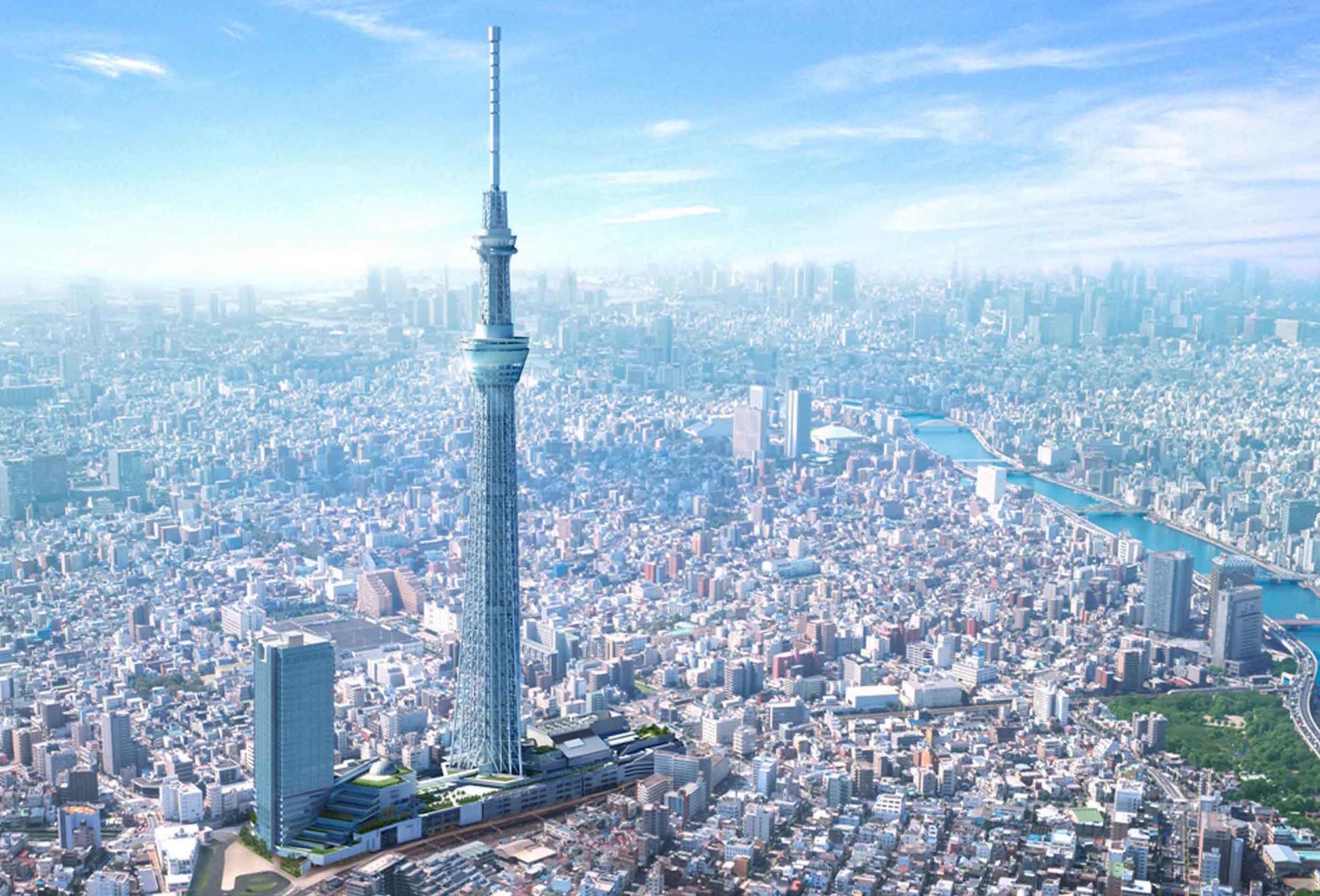
东京晴空塔[1](日语:東京スカイツリー/とうきょうスカイツリー Tōkyō sukai tsurī */?;英语译名:Tokyo Skytree),又译称东京天空树、新东京铁塔,是位于日本东京都墨田区的电波塔,由东武铁道及其子公司东武塔晴空塔共同筹建,于2008年7月14日动工,2012年2月29日完工、同年5月22日正式启用。其高度为634米,于2011年11月17日获得吉尼斯世界纪录认证为“世界第一高塔”,成为全世界最高的自立式塔形建筑[2];目前亦为世界第二高的人工构造物,仅次于哈里发塔。
Der Tokyo Skytree (jap. 東京スカイツリー, Tōkyō Sukaitsurī) ist ein 634 Meter hoher Fernseh- und Rundfunksendeturm in der japanischen Hauptstadt Tokio. Er wurde am 22. Mai 2012 eröffnet.[1] Er ist der höchste Fernsehturm und nach dem Burj Khalifa in Dubai das zweithöchste Bauwerk der Erde.
Der Tokyo Skytree steht im Stadtteil Oshiage des Bezirks Sumida und übertrifft mit einer Höhe von 634 Metern[2] den 333 Meter hohen Tokyo Tower in Minato um etwa 90 Prozent. Der Turm steht auf dem Gelände eines alten Rangierbahnhofes der Tōbu-Bahngesellschaft, die den Hauptteil der damals geschätzten Gesamtkosten von circa 60 Milliarden Yen,[3] umgerechnet rund 460 Millionen Euro, übernehmen wollte. Der restliche Betrag sollte von den sechs an dem Projekt beteiligten Fernseh- und Rundfunksendern getragen werden.
Die Gesellschafter haben am Fuße des Turmes ein großes Einkaufszentrum („Plaza“) gebaut, das die Bewohner der Umgebung und Touristen, die auf die Fahrt auf den Turm warten, als Zielgruppe hat. Das Gebäude ist an den bisherigen Bahnhof Oshiage angeschlossen und damit mit den Knotenpunkten Tokyos verbunden. Der Bahnhof von Oshiage wird von der Hanzōmon-Linie der Tōkyō Metro, der Toei Asakusa-Linie, der Keisei Oshiage-Linie und der Isesaki-Linie von Tōbu angefahren.
東京スカイツリー(とうきょうスカイツリー、英: TOKYO SKYTREE)は、東京都墨田区押上一丁目にある電波塔(送信所)である。観光・商業施設やオフィスビルが併設されており、ツリーを含め周辺施設は「東京スカイツリータウン」と呼ばれる。2012年(平成24年)5月に電波塔・観光施設として開業した。
東京スカイツリーについての名称・ロゴマーク・シルエットデザイン・完成予想コンピュータグラフィックスといった知的財産は東武グループの一社である東武タワースカイツリー株式会社等の著作権および商標権により保護されている。このため公式案内では「東京スカイツリー®」と®マークが記載されている[1]。
Tokyo Skytree (東京スカイツリー Tōkyō Sukaitsurī) is a broadcasting, restaurant,[3] and observation tower in Sumida, Tokyo, Japan. It became the tallest structure in Japan in 2010[4] and reached its full height of 634.0 metres (2,080 ft) in March 2011, making it the tallest tower in the world, displacing the Canton Tower,[5][6] and the second tallest structure in the world after the Burj Khalifa (829.8 m/2,722 ft).[7]
The tower is the primary television and radio broadcast site for the Kantō region; the older Tokyo Tower no longer gives complete digital terrestrial television broadcasting coverage because it is surrounded by high-rise buildings. Skytree was completed on Leap Day, 29 February 2012, with the tower opening to the public on 22 May 2012.[8] The tower is the centrepiece of a large commercial development funded by Tobu Railway and a group of six terrestrial broadcasters headed by NHK. Trains stop at the adjacent Tokyo Skytree Station and nearby Oshiage Station. The complex is 7 km (4.3 mi) north-east of Tokyo Station.
La Tokyo Skytree (東京スカイツリー, Tōkyō Sukaitsurī) est une tour de radiodiffusion du Japon, située dans l'arrondissement Sumida de Tokyo. Haute de 634 mètres, elle devient, le jour de son inauguration en 2012, la deuxième plus haute structure autoportante du monde. Initialement prévue pour mesurer 610 mètres, la Tokyo Skytree culmine finalement à 634 mètres4, soit près du double de la Tour de Tokyo5. Elle possède trois pieds pour une stabilité maximale et une meilleure résistance aux séismes3. Sa forme à partir de la mi-hauteur est cylindrique pour une meilleure résistance aux vents. Deux plates-formes d'observation à 350 et 450 mètres offrent un large panorama sur la ville6,7.
La Tokyo Sky Tree (東京スカイツリー Tōkyō sukai tsurī?) è una torre per telecomunicazioni e panoramica che sorge a Sumida, quartiere speciale di Tokyo, in Giappone.
Completata nel 2012,[2] già dal 2010 è la torre più alta del Giappone[3] e, con i suoi 634 metri di altezza, è la torre più alta al mondo e la seconda struttura artificiale più alta al mondo dopo il grattacielo Burj Khalifa di Dubai.[3]
Tokyo Skytree (東京 スカイ ツリー Tōkyō Sukai Tsurī?)1, antes conocida como la Nueva Torre de Tokio, es una torre de radiodifusión, restaurante y mirador construida en Sumida, Tokio, Japón. Es la estructura artificial más alta en Japón desde 2010. Con una altura de 634 m, fue completada el 29 de febrero de 2012 e inaugurada el 22 de mayo de 2012.
El proyecto fue liderado por Tobu Railway y un grupo de seis emisoras terrestres (encabezada por la cadena pública NHK). La estructura completa es el punto culminante de un desarrollo comercial masivo, ya que se encuentra equidistante entre las estaciones de Narihirabashi y Oshiage.
Uno de los propósitos principales de la Tokyo Skytree es ser una torre de televisión y radiodifusión. La torre de radiodifusión actual de Tokio, la Torre de Tokio, tenía una altura original de 333 m, aunque perdió su antena analógica el 14 de julio de 2012, quedándose en 315 m de altura, y ya no es lo suficientemente alta como para dar cobertura digital completa, ya que está rodeada de muchos edificios de gran altura.
La Tokyo Skytree es la torre más alta del mundo, no considerando así a los edificios, superando a la Torre de televisión de Cantón (600 m, 1969 pies), la estructura más alta en una isla, más alta que el Taipei 101 y la segunda estructura más alta del mundo después del Burj Khalifa.
Tokyo Skytree (яп. 東京スカイツリー то:кё: сукай цури:, досл. Токийское небесное дерево) — телевизионная башня в районе Сумида, Токио, Япония, самая высокая среди телебашен мира[2]. Второе по высоте сооружение в мире после «Бурдж-Халифа».
Во время строительства башня была известна под названием Новая Токийская башня. Название «Tokyo Sky Tree» было выбрано по итогам конкурса, который проходил в интернете с апреля по май 2008 года.
Высота телебашни вместе с антенной составляет 634 метра[2], что почти в два раза выше Токийской телевизионной башни. Высота башни была выбрана так, чтобы цифры: 6 (на старом японском «му»), 3 («са»), 4 («си») были созвучны «Мусаси» — названию исторической области, где находится современный Токио[3].







